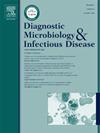The value of targeted next-generation sequencing in the diagnosis and differential diagnosis of paucibacillary pulmonary tuberculosis
IF 2.1
4区 医学
Q3 INFECTIOUS DISEASES
Diagnostic microbiology and infectious disease
Pub Date : 2025-04-22
DOI:10.1016/j.diagmicrobio.2025.116866
引用次数: 0
Abstract
Background
The diagnostic utility of broad-spectrum pathogen-specific targeted next-generation sequencing (tNGS) for paucibacillary pulmonary tuberculosis (PTB) in general hospital settings remains insufficiently characterized compared to validated Mycobacterium-specific tNGS.
Objective
To investigate the clinical value of broad-spectrum pathogen-specific tNGS in diagnosing and differentially diagnosing paucibacillary PTB in real-world clinical practice.
Methods
This retrospective study analyzed data from 423 patients admitted to the First Affiliated Hospital of Chongqing Medical University from January 1, 2024, to October 31, 2024. Patients underwent bronchoalveolar lavage fluid (BALF) testing, including acid-fast staining, culture, Xpert MTB/RIF, and tNGS. 47 participants were excluded based on predefined criteria.
Results
Among 83 microbiologically confirmed PTB cases, tNGS exhibited significantly higher sensitivity compared to Xpert and culture (91.6 % vs. 79.5 % for Xpert and 73.5 % for culture; p<0.001), albeit with marginally lower specificity than Xpert (95.6 % vs. 98.6 %; p=0.01). For 293 non-TB patients, tNGS detected pathogens in 86.7 % (254/293) of BAL samples, identifying 300 pathogens with 47.3 % (142/300) concordance to clinical diagnoses.
Conclusion
Broad-spectrum pathogen-specific tNGS demonstrated enhanced sensitivity for diagnosing paucibacillary PTB but slightly reduced specificity relative to Xpert. While it achieved high pathogen detection rates in non-TB pulmonary diseases, its concordance with clinical diagnoses was suboptimal.
靶向新一代测序在少杆菌性肺结核诊断和鉴别诊断中的价值
背景:广谱病原体特异性靶向下一代测序(tNGS)在普通医院对少杆菌性肺结核(PTB)的诊断效用与已验证的分枝杆菌特异性tNGS相比,仍未充分表征。目的探讨广谱病原体特异性tNGS在临床诊断和鉴别诊断少杆菌性肺结核中的临床价值。方法回顾性分析重庆医科大学第一附属医院于2024年1月1日至2024年10月31日收治的423例患者的资料。患者接受支气管肺泡灌洗液(BALF)检测,包括抗酸染色、培养、Xpert MTB/RIF和tNGS。根据预先确定的标准,排除了47名参与者。结果在83例微生物学确诊的肺结核病例中,tNGS的敏感性明显高于Xpert和培养法(91.6% vs. Xpert和培养法分别为79.5%和73.5%;p<0.001),尽管特异性略低于Xpert (95.6% vs. 98.6%;p = 0.01)。293例非结核患者的BAL样本中,tNGS检出病原菌86.7%(254/293),鉴定出300种病原菌,与临床诊断的符合率为47.3%(142/300)。结论广谱病原菌特异性tNGS诊断少杆菌性肺结核的敏感性提高,但特异性较Xpert略有降低。虽然它在非结核性肺部疾病中获得了很高的病原体检出率,但与临床诊断的一致性并不理想。
本文章由计算机程序翻译,如有差异,请以英文原文为准。
求助全文
约1分钟内获得全文
求助全文
来源期刊
CiteScore
5.30
自引率
3.40%
发文量
149
审稿时长
56 days
期刊介绍:
Diagnostic Microbiology and Infectious Disease keeps you informed of the latest developments in clinical microbiology and the diagnosis and treatment of infectious diseases. Packed with rigorously peer-reviewed articles and studies in bacteriology, immunology, immunoserology, infectious diseases, mycology, parasitology, and virology, the journal examines new procedures, unusual cases, controversial issues, and important new literature. Diagnostic Microbiology and Infectious Disease distinguished independent editorial board, consisting of experts from many medical specialties, ensures you extensive and authoritative coverage.

 求助内容:
求助内容: 应助结果提醒方式:
应助结果提醒方式:


